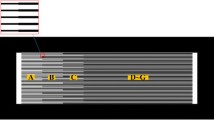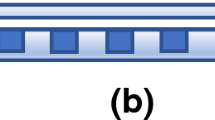Abstract
Effective cooling technology is intensely demanded to cool the electronic devices within small space under high heat flux. Mini-grooved flat heat pipe (FHP) with simple structure, close contact with heat source, uniform temperature and high thermal conductivity can satisfy the demand of transferring the great heat rapidly and weakening the hot spot of electronic devices. As fine wick feature and distribution played a critical part in improving the performance of mini-grooved FHP, a thermal experiment was established to explore the heat transfer characterization of mini-grooved FHP with different wick structures and distributions. And a mathematical model in one dimension was set up to investigate the fluid flow and heat transmission performance of FHP with V-type or rectangle-type grooves, expecting to assist the experiment in understanding the operating mechanisms of mini-grooved FHP further. Effects of input heat, inclined angle, working temperature and wick structure were examined. It is found that among the V-type, rectangle-type and block-type mini-grooved FHPs, V-type FHP presents better heat transfer rate, while block-type FHP displays larger maximum heat transfer amount. V2 sloped convex gradient mini-grooved FHP owns the optimum overall performance. It possesses the merits of narrower grooves at the evaporation section, wider grooves at the condensation section and larger vapor chamber space, which can optimize the liquid and vapor circulation processes inside the FHP. Its thermal resistance and maximum temperature reduce by almost 9.7% and 3.4% separately in comparison with those of V1 straight mini-grooved FHP, which is beneficial to guarantee the reliability and stability of electronic devices.











Similar content being viewed by others
Abbreviations
- A :
-
Area, m2
- c p :
-
Specific heat capacity at constant pressure, J kg−1 K−1
- D :
-
Relative uncertainty
- D h :
-
Hydraulic diameter, m
- dT :
-
Temperature non-uniformity
- f 0 :
-
Friction, N
- g :
-
Gravity, m2·s−1
- h :
-
Height, m
- h fg :
-
Latent heat, J kg−1
- h i * :
-
Convective heat transfer coefficient, W·m−2 K−1
- l :
-
Length, m
- p :
-
Pressure, Pa
- Q :
-
Input heat, W
- Q’ :
-
Heat transfer amount, W
- R :
-
Thermal resistance, K W−1
- Re:
-
Reynolds number
- Rg :
-
Mass ideal gas constant, J kg−1 K−1
- r :
-
Capillary radius, m
- S :
-
Uncertainty
- s :
-
Thickness, m
- T :
-
Temperature, °C
- \(\overline{T}\) :
-
Average temperature, °C
- u :
-
Axial velocity, m s−1
- V :
-
Volume, m3
- w :
-
Width, m
- X :
-
Direct measurement value
- Y :
-
Indirect measurement value
- z :
-
Axial coordinate direction
- α :
-
Half V-type angle value, °
- α v :
-
Vapor accommodation coefficient
- η :
-
Liquid amount ratio
- λ :
-
Thermal conductivity, W m K−1
- μ :
-
Dynamic viscosity, N s m−2
- ρ :
-
Density, kg m−3
- τ :
-
Shear stress, N m−2
- ϕ :
-
Inclined angle, °
- adia:
-
Adiabat
- ave:
-
Average
- b:
-
Boss
- c:
-
Capillary
- con:
-
Condensation
- eva:
-
Evaporation
- f:
-
Fluid
- g:
-
Groove
- I:
-
Current
- l:
-
Liquid
- max:
-
Maximum
- min:
-
Minimum
- N:
-
Number
- Q:
-
Input heat
- Q loss :
-
Heat loss
- R:
-
Thermal resistance
- s:
-
Saturation
- T:
-
Temperature
- U:
-
Voltage
- v:
-
Vapor
- w:
-
Wick
References
Mansouri J, Saad I, Maalej S, Driss A, Zaghdoudi MC. Thermal performance evaluation of a water-filled axially grooved copper fat heat pipe for electronics cooling. J Therm Anal Calorim. 2022;147:8579–612.
Lewis D (2020) A key development in the drive for energy-efficient electronics. Eurekalert. 2020. https://www.eurekalert.org/pub_releases/2020-03/uol-akd032320.php. Accessed 23 Mar 2020.
Jian Q, Wu H, Ping C, Qian W, Qin S. Recent advances in MEMs-based micro heat pipes. Int J Heat Mass Transf. 2017;110:294–313.
Liang K, Li Z, Chen M, Jiang H. Comparisons between heat pipe, thermoelectric system, and vapour compression refrigeration system for electronics cooling. Appl Therm Eng. 2019;146:260–7.
Wang Z, Huang Z, Chen F, Zhao X, Guo P. Experimental investigation of the novel BIPV/T system employing micro-channel flat-plate heat pipes. Build Serv Eng Res T. 2018;39(5):540–56.
Tang H, Yong T, Jie L, Sun Y, Peng R. Experimental investigation of the thermal performance of heat pipe with multi-heat source and double-end cooling. Appl Therm Eng. 2018;131:159–66.
Zaghdoudi MC, Maalej S, Mansouri J, Sassi BHM. Flat miniature heat pipes for electronics cooling: state of the art, experimental and theoretical analysis. Int J Mech Mechatron Eng. 2011;5(3):714–37.
Vasiliev LL, Grakovich LP, Rabetsky M, Romanenkov V, Hugon J (2012) Grooved heat pipe evaporators with porous coating. In: 16th International Heat Pipe Conference (16th IHPC), Lyon, France, May 20–24.
Khalid SU, Hamza B, Ali HM, Janjua MM, Ali MA. Heat pipes: progress in thermal performance enhancement for microelectronics. J Therm Anal Calorim. 2021;143(3):2227–43.
Anand AR. Analytical and experimental investigations on heat transport capability of axially grooved aluminium-methane heat pipe. Int J Therm Sci. 2019;139:269–81.
Zhang X, Jiang D, Wang H, Liu X. Experimental analysis on the evaporator startup behaviors in a trapezoidally grooved heat pipe. Appl Therm Eng. 2021;199(8):117558.
Gou X, Zhang Q, Li Y, Liu Y, Liu S, Iram S. Experimental research on the thermal performance and semi-visualization of rectangular flat micro-grooved gravity heat pipes. Energies. 2018;11:2480.
Yu F, Yu C, Cao J, Chen Y. Experimental analysis of the evaporation regimes of an axially grooved heat pipe at small tilt angles. Int J Heat Mass Transf. 2018;126:334–41.
Tang Y, Hu Z, Qing J, Xie Z, Fu T, Chen W. Experimental investigation on isothermal performance of the micro-grooved heat pipe. Exp Therm Fluid Sci. 2013;47:143–9.
Alijani H, Çetin B, Akkuş Y, Dursunkaya Z. Effect of design and operating parameters on the thermal performance of aluminum flat grooved heat pipes. Appl Therm Eng. 2017;132:174–87.
Cecere A, Cristofaro DD, Savino R. Visualization of liquid distribution and dry-out in a single-channel heat pipes with different wettability. Exp Therm Fluid Sci. 2018;96:234–42.
Chang C, Han Z, He X, Wang Z, Ji Y. 3D printed aluminum flat heat pipes with micro grooves for efficient thermal management of high power LEDs. Sci Rep. 2021;11:8255.
Lucas R. Rate of capillary ascension of liquids. Kolloid Z. 1918;23:15–22.
Washburn EW. The dynamics of capillary flow. Phys Rev. 1921;17(3):273–83.
Wang XD, Zou LL, Liu JG, Luo Y, Yu BK. Experimental investigation of copper-grooved micro heat pipes (MHPs). J Solid State Lighting. 2014;1(1):1–8.
Nagayama G, Gyotoku S, Tsuruta T. Thermal performance of flat micro heat pipe with converging microchannels. Int J Heat Mass Transf. 2018;122:375–82.
Singh M. Capillarity enhancement of micro heat pipes using grooves with variable apex angle. Int J Therm Sci. 2020;150:106239.
Zhang W, Wen X, Yang S, Berta Y, Wang ZL. Single-crystalline scroll-type nanotube arrays of copper hydroxide synthesized at room temperature. Adv Mater. 2003;15(10):822–5.
Chen JS, Chou JH. Cooling performance of flat plate heat pipes with different liquid filling ratios. Int J Heat Mass Transf. 2014;77:874–82.
Iverson BD, Davis TW, Garimella SV, North MT. Heat and mass transport in heat pipe wick structures. J Thermophys Heat Tr. 2007;21(2):392–404.
Sadrameli SM, Forootan D, Farajimoghaddam F. Effect of working fluid inventory and heat input on transient and steady state behavior of a thermosyphon. J Therm Anal Calorim. 2021;143(3):3825–34.
Shaeri MR, Attinger D, Bonner R. Feasibility study of a vapor chamber with a hydrophobic evaporator substrate in high heat flux applications. Int Commun Heat Mass. 2017;86:199–205.
Liu Y, Han X, Shen C, Yao F, Zhang M. Experimental study on the evaporation and condensation heat transfer characteristics of a vapor chamber. Energies. 2019;12:11.
Li Y, Chen S, He B, Yan Y, Li B. Effects of vacuuming process parameters on the thermal performance of composite heat pipes. Appl Therm Eng. 2016;99:32–41.
Mooney JP, Punch J, Jeffers N, Egan V. An accurate calorimeter-based method for the thermal characterization of heat pipes. Exp Therm Fluid Sci. 2021;125:110381.
Moffat RJ. The measurement chain and validation of experimental measurements. ACTA IMEKO. 2014;3(1):16–8.
Xin F, Ma T, Wang Q. Thermal performance analysis of flat heat pipe with graded mini-grooves wick. Appl Energ. 2018;228:2129–39.
Kakaç S, Shah RK, Aung W. Handbook of single-phase convective heat transfer. New York: Wiley; 1987.
Do KH, Kim SJ, Garimella SV. A mathematical model for analyzing the thermal characteristics of a flat micro heat pipe with a grooved wick. Int J Heat Mass Transf. 2008;51(19–20):4637–50.
Schneider G (1980) Non-dimensional analysis for the heat transport capability of axially grooved heat pipes including liquid/vapor interaction. In: 18th aerospace sciences meeting, Pasadena, USA
Suh JS, Greif R, Grigoropoulos CP. Friction in micro-channel flows of a liquid and vapor in trapezoidal and sinusoidal grooves. Int J Heat Mass Transf. 2001;44(16):3103–9.
Hung YM. Effects of geometric design on thermal performance of star-groove micro-heat pipes. Int J Heat Mass Transf. 2011;54(5–6):1198–209.
Lefèvre F, Rullière R, Pandraud G, Lallemand M. Prediction of the temperature field in flat plate heat pipes with micro-grooves - experimental validation. Int J Heat Mass Transf. 2008;51:4083–94.
Acknowledgements
This work is financially supported by National Natural Science Foundation of China (Grant No. 52106108) and Postdoctoral Science Foundation of China (Grant No. 2021M702545).
Author information
Authors and Affiliations
Contributions
All authors contributed to the study. Material preparation, data collection and analysis were performed by FX, TM and QW. The first draft of the manuscript was written by FX and all authors commented on previous versions of the manuscript. All authors read and approved the final manuscript.
Corresponding author
Ethics declarations
Conflict of interest
The authors declare that they have no known competing financial interests or personal relationships that could have appeared to influence the work reported in this paper.
Additional information
Publisher's Note
Springer Nature remains neutral with regard to jurisdictional claims in published maps and institutional affiliations.
Rights and permissions
Springer Nature or its licensor (e.g. a society or other partner) holds exclusive rights to this article under a publishing agreement with the author(s) or other rightsholder(s); author self-archiving of the accepted manuscript version of this article is solely governed by the terms of such publishing agreement and applicable law.
About this article
Cite this article
Xin, F., Ma, T., Wang, Q. et al. Thermal characterization and wick optimization of mini-grooved flat heat pipe for electronics cooling. J Therm Anal Calorim 147, 14859–14872 (2022). https://doi.org/10.1007/s10973-022-11739-0
Received:
Accepted:
Published:
Issue Date:
DOI: https://doi.org/10.1007/s10973-022-11739-0




